爱尔兰英文PPT介绍
爱尔兰英语国家概况50页PPT

Russian National Flag
German National Flag
French German
Russian Irish
Irish Harp is so closely associated with Irish identity that it serves as the nation's national emblem.
The Celtic tribes arrived in the island about the 6th century BC.
In the 9th century the Viking 北欧海盗 invasions began. They were driven away in about 1014.
French National Flag, also known as the French tricolour, The Tricolour was used during the French Revolution and has since become a symbol of liberty around the world. Other nations have also adopted the design, usually associated with Freedom 自由, Equality 平等 and Fraternity (Brotherhood) 博爱.
The Liffey River flows through Dublin.
The Shannon River (370 km long; Severn River: 338 km; Thames River: 336 km.) is the longest river in the British Isles. It consists of a chain of lakes, begins in the northwest and flows southwest before reaching the Atlantic Ocean through a wide, lengthy estuary 河口. It provides electric power for much of the country.
英语国家概况之爱尔兰

4. Total land area: 81,421 Sq km.
5. The highest peak is Carrauntoohil 1,041
m. The River Shannon, at 386 km is the longest rivery
1. Prehistory civilization
2. Celts – 600 BCE 3. St. Patrick , 432– Catholicism
Megaliths
Stone circle in County Cork, ca 3500BC
St. Patrick and Catholicism
1.5 Flora
Forests now cover about 9% (4,450 km or one million acres) of the land. Because of its mild climate, many species, including sub-tropical species such as palm trees, are grown in Ireland. Much of the land is now covered with pasture, and there are many species of wild-flower. Gorse (Ulex europaeus), a wild furze, is commonly found growing in the uplands, and ferns are plentiful in
the more moist regions, especially in the western parts of Ireland.
爱尔兰的介绍 英文版
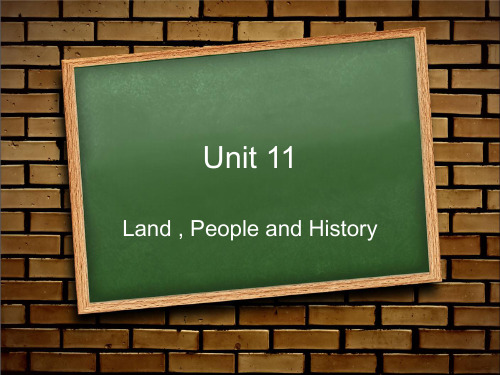
Land , People and History
Geography,Land and Environment
• Ireland is a small island off the northwest coast of Great Britain,ddivided from Scotland by a narrow strait of water. • Today,when people use the word "Ireland" they may mean the whole island,which is actually divided into two quite distinct jurisdictions,that of Northern Ireland,which is a povince of Great Britain, and the present Republic of Ireland.
Early Mondern Period
• Also from the 16th century onwards ,the English sought to consolidate their military victoies over their Irish colony by seeking to impose their own brang of Christianity ,called Protestantism . Partly because of its close association with the repressive repressive policies of the english adminisration ,the new reformed version of Christianity was resisted fiercely in Ireland.
爱尔兰英文介绍(课堂PPT)
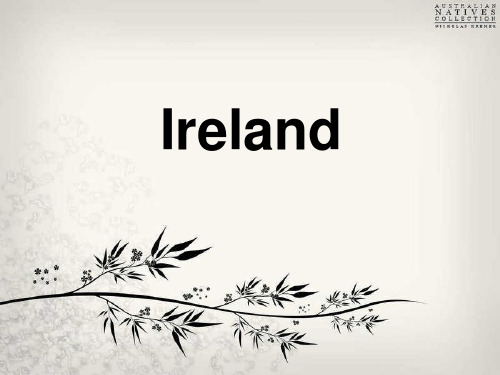
• The Celts
The Celts were commonly thought to have come to Ireland as early as the 6th century BC, with subsequent groups arriving up to the time of Christ. The Celts had deep influence on Ireland. Among all the legacies of the Celts, it is their language that has proved the most lasting. Along with the language, the Celts also brought an instrument of social and cultural unity and a legal system to the island.
Christianity
Christianity was introduced into Ireland some time in the 5th century. Traditionally, it was said to have been brought by Saint Patrick. Although there were some Christians in Ireland before Patrick's arrival, by the time of his death in 461 AD, the whole island was effectively Christian.
14
• Early Modern Period
In 1541, Henry Ⅷ declared himself king of Ireland---the first English monarch to do so. Queen ElizabethⅠcontinued and amplified her father’s Irish campaigns. When her army defeated the Irish at the Battle of Kinsale in 1601, the native political system was overthrown and, for the first time, the entire island was controlled by a strong English central government. Because of the repressive policies of the English administration, the English Protestantism was resisted in Ireland. When the new English republic was established under Oliver Cromwell, he took such drastic measures to crush the rebellion on Irish soil that the massacres of his parliamentary army are still recalled today.
爱尔兰经济介绍PPT
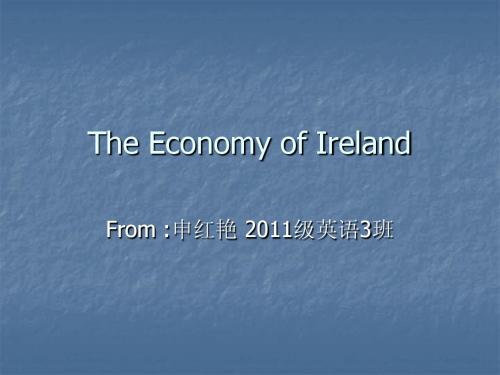
Over-heating------an economic crisis
Causes : 1.people’s desire for owning their own houses 2.a lot of loan from banks cking sufficient regulations from the government. Solutions: revising its economic policies, enforcing strict budget restrictions and bailing out the banks
As
of 2008, exports---industrial produce:92.7﹪;agricultural produce:5.8﹪ Clearly ,over the last forty years, Ireland has made the transition from a traditional agrarian economy to one both modern and industrial.
Summary
The EU makes a great difference in
Ireland ,including economy and social life The EU is a watershed in its history.
The
End
Reasons for Economy Growing
A population boom The reform of education The government had a conversion to market economics ------Ireland’s entrance into the EU in 1973
Ireland爱尔兰英文介绍PPT
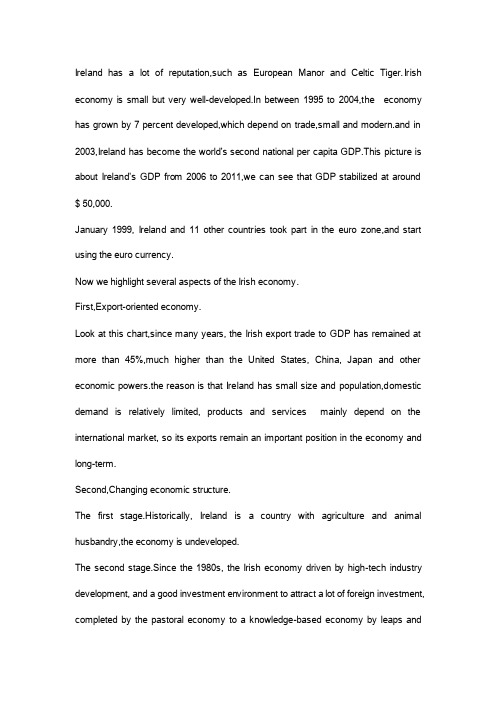
Ireland has a lot of reputation,such as European Manor and Celtic Tiger.Irish economy is small but very well-developed.In between 1995 to 2004,the economy has grown by 7 percent developed,which depend on trade,small and modern.and in 2003,Ireland has become the world's second national per capita GDP.This picture is about Ireland's GDP from 2006 to 2011,we can see that GDP stabilized at around $ 50,000.January 1999, Ireland and 11 other countries took part in the euro zone,and start using the euro currency.Now we highlight several aspects of the Irish economy.First,Export-oriented economy.Look at this chart,since many years, the Irish export trade to GDP has remained at more than 45%,much higher than the United States, China, Japan and other economic powers.the reason is that Ireland has small size and population,domestic demand is relatively limited, products and services mainly depend on the international market, so its exports remain an important position in the economy and long-term.Second,Changing economic structure.The first stage.Historically, Ireland is a country with agriculture and animal husbandry,the economy is undeveloped.The second stage.Since the 1980s, the Irish economy driven by high-tech industry development, and a good investment environment to attract a lot of foreign investment, completed by the pastoral economy to a knowledge-based economy by leaps andbounds.Since 1995, the Irish economy continued to grow rapidly, becoming the Organization for Economic Cooperation and Development of the fastest growing economies in countries.The third stage.Since 2008, the international financial crisis,Ireland began to change the economic structure,increasing the proportion of tertiary industry in the economy.Through this chart, we can see services accounted for 70 percent of GDP, as the economy leading industries.。
【精品】ireland_presentation_爱尔兰介绍英文PPT课件
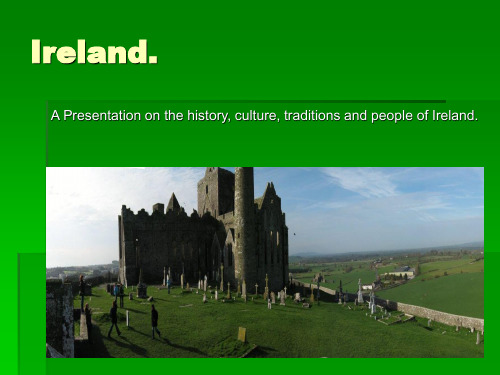
Independence and the division of
Ireland.
▪ Michael Collins had led the war effort against Britain.
▪ Norman castles can be found across Ireland.
The start of British rule in
Ireland.
▪ In 1171 King Henry 2 of England came to Ireland to claim sovereignty over Ireland.
The Great Famine 18451850
▪ Thple at this time was the potato.
▪ The potato was almost entirely releyed upon by Irish people.
▪ The Vikings especially raided Christian monasteries where precious treasures and goods could be stolen.
▪ The monks built tall round towers to hide in when the Vikings attacked.
▪ Many people died or emigrated to America.
▪ Since the 1840s emigration became a part of Iirsh life up until the late 1990s.
爱尔兰英文PPT
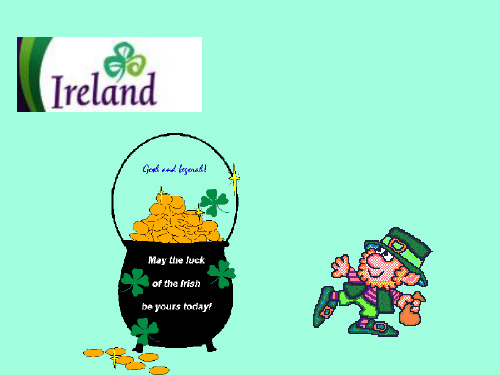
Celtic music uses traditional instruments such as the fiddle, tin whistle, and bodhran (Irish drum).
(Animated photo from: /world/ireland/bodhranintro.htm)
Castles and ruins are found all over Ireland.
(Photo fபைடு நூலகம்om: /northern-ireland/ukiant01.htm)
The Giant’s Causeway is a mass of stone columns that extend from a cliff in Northern Ireland and disappear under the sea towards Scotland. They were formed by a volcanic eruption 60 million years ago. However, the ancients believed it to be the work of a giant named Fin M’Coul.
The National Holiday is March 17, St. Patrick’s Day, named after the Patron Saint of Ireland.
(Photo from:/)
Most people in Ireland speak English, but a few still speak Gaelic. You might hear someone say “Erin go bragh” on St. Patrick’s Day, which is Gaelic for “Ireland forever.”
爱尔兰的介绍英文版

The Celts
• It is important to emphasize that ireland already had quite a sophisticated before the which were to transform it radically;that of the celts. it is believed that the celtics,originally thougt to be in the invaders , gradually into i
• Rival colonialists of the Neolithic,or new Stone Age ,period reached Irelang around 3000BC. these were farmers who raised animals and cultivated the soil.
Prehistory
• The earliest settler arrived around 7000 BC in the Mesolithic or middle Stone Age period. Evidence suggests that they arrived in the nonth of the island,across the narrow strait from northern Britain.these people were mainly huners.
The 18th Century
• In implementing such repressive measures ,the island of the Bitish colonies .But it have been rendered British colony -in the American war of independence (1776-1783)was the revolt of another British colony. that initiated radical changes in the Irish politics .Encouraged by the Americn examples.,the Protestant ascendancy began to press for a measure the American examle.
Ireland 爱尔兰简介英文版PPT课件

• Corned beef and Cabbage, potato pancakes
• Irish Beef Stew, Sheppard's Pie, Coddle
• Alcoholic Drinks: Guinness Beer, Irish cream
15
2020/1/1
16
• During the famine approximately 1 million people died and a million more emigrated from Ireland, causing the island's population to fall by between 20% and 25%.
2
Céad Mile Fáilte! Welcome to Ireland!
•Ireland means: •Eire – Green •Land – land, island
•Why? Because the island is full of shamrocks and clovers!
3
Some famous Irish ຫໍສະໝຸດ eople and Musicians
5
Important historical events in Ireland
• 1. Bloody Sunday
• sometimes called the Bogside Massacre—was an incident on 30 January 1972 in the Bogside area of Derry, Northern Ireland, in which 26 unarmed civil-rights protesters and bystanders were shot by soldiers of the British Army.
ireland_presentation_爱尔兰介绍

where the Irish Government meets in Dublin.
Other sights of Dublin
The streets in the centre of the city are narrow, with little space for cars.
Gaelic Football
Gaelic Football is
different from normal football because players can use their hands. There are 15 players on each team. The playing field is much larger than a soccer field.
The start of British rule in Ireland.
In 1171 England conquered
Ireland Since the 1840s emigration became a part of Iirsh life up until the late 1990s The 1916 Rising was the start of the War of Independence against England. Civil war in Ireland 1921-1923 Continued social division in Northern Ireland
group leader:彭青青Melody Geography and Climate:陈静禄Better Irish History:黄锋
Sport in Ireland:陈立峰LEE Culture, Customs and Tradition:鲁智立
最新爱尔兰国家概况ppt课件
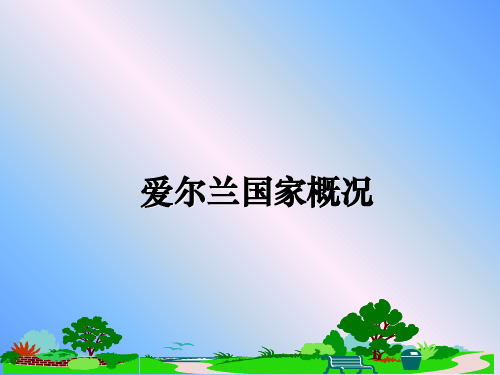
一. 国内经济(Domestic Economy)
❖ (一)自然资源: 铅锌矿储量丰富,是欧洲最大的铅
锌生产国。泥煤(peat)分布占全国面积的13%。天然气 储量估计为382亿立方米。所需能源的70%依靠进口。
❖ (二)交通运输:内陆交通运输以公路和铁路为主。 绝大多数国际贸易货物运输 由海运承担。主要港口有都柏林、 香农(Shannon) 、科克(Cork)等。主要有都柏林、香农
Ⅴ.文教与大众传媒(Education and Mass Media)
❖ 一.教育(Education)
中小学实行义务教育。著名高等学府有爱尔兰 国立大学(National University of Ireland)、 都柏林大学(Trinity College, Dublin)、利默 里克大学(University of Limerick)和都柏林 市大学(Dublin City University)等。
❖ 四.司法机构(Judiciary) 最高法院(Supreme Court)即终审法院为最高 司法机关,下设高等法院(High Court)、巡回 法院(Circuit Court)和地区法院(District Court)。法官由政府推荐,总统任命。另设特 别刑事法院(Special Criminal Court)。
爱尔兰国家概况
Introduction
❖ 国名:爱尔兰(Ireland) ❖ 独立日:12月6日(1921
年) ❖ 国庆日:3月17日圣帕特里克
日(St. Patrick‘s Day) ❖ 国旗:呈横长方形,长与宽之比
为2∶1。从左至右由绿、白、 橙三个平行相等的竖长方形组成。 ❖ 国徽:为盾徽。天蓝色的盾面上 绘有金黄色的竖琴。蓝色象征大 海和天空,竖琴为爱尔兰人民喜 爱的“天使之琴”。 ❖ 人口:392万(2002年)。 绝大部分为爱尔兰人。居民91. 6%信奉罗马天主教,其他居民 信奉基督教新教等。
爱尔兰国家介绍PPT

5.Irish Independence
5)Home Rule (地方自治)in 1914
In 1870, a constitutional movement seeking Home Rule was instituted up by Isaac Butt.The Home Rule Bill(自治法案) was finally passed in 1914.
Ireland
4.English invasion
1771 Henry VIII declared himself king of Ireland
Henry II,establish himself as overlord of Ireland
1541
1601 Queen Elizabeth I’s army defeated the Irish at the Battle of Kinsale the English sought to impose their Protestantism in the Irish colony 1800 from 16th century onward
2)During and after the Great Famine ① Who : People all over Ireland. ② Why : As a result of Great Famine. ③ Destination : The New World. ④ Result the immmediate result of Great Famine was a decimation of population,which about half its population lost.
介绍北爱尔兰和平进程(英语PPT)

a power-sharing executive
In January 1974, the British Prime Minister Edward Heath set up a power-sharing executive which involved representatives from both the Republic and the North of Ireland as well as Great Britain in the governance of the North. However, this was brought down by the concerted efforts of the Protestant loyalists.
The referendum campaign
On 22 May 1998, The referenda were held. The pro-agreement was promoted to the nationalist community as delivering civil rights, inclusive government, recognition of their Irishness, and a peaceful route to Irish reunification. To the unionist community, it was presented as bringing an end to the troubles, a guaranteed end to paramilitaries and their weapons, and a guarantee of the Union for the foreseeable future.
- 1、下载文档前请自行甄别文档内容的完整性,平台不提供额外的编辑、内容补充、找答案等附加服务。
- 2、"仅部分预览"的文档,不可在线预览部分如存在完整性等问题,可反馈申请退款(可完整预览的文档不适用该条件!)。
- 3、如文档侵犯您的权益,请联系客服反馈,我们会尽快为您处理(人工客服工作时间:9:00-18:30)。
National emblem
National lag
outline
• Geography • History
• Politics
• Economy
• Culture
• Advice for conversation
Geography
Ireland is a small island off the northwest cost of Great Britain, divided from Scotland by a narrow strait of water.
The Parliament or Dail enacts all legislation for the country. This legislation is interpreted by a hierarchy of courts. At the bottom of this ladder is the District Court. The next rung is represented by the Circuit Court, which tries more serious cases. The next rung on the ladder is called the High Court. The High Court has full jurisdiction and determining power in all matters of law or fact. The Supreme Court is the court of final appeal.
• The Celts
The Celts were commonly thought to have come to Ireland as early as the 6th century BC, with subsequent groups arriving up to the time of Christ. The Celts had deep influence on Ireland. Among all the legacies of the Celts, it is their language that has proved the most lasting. Along with the language, the Celts also brought an instrument of social and cultural unity and a legal system to the island.
• Early Modern Period
In 1541, Henry Ⅷ declared himself king of Ireland---the first English monarch to do so.
Queen ElizabethⅠcontinued and amplified her father’s Irish campaigns. When her army defeated the Irish at the Battle of Kinsale in 1601, the native political system was overthrown and, for the first time, the entire island was controlled by a strong English central government. Because of the repressive policies of the English administration, the English Protestantism was resisted in Ireland.
• The Middle Ages
From around 800 onwards Vikings marauders attacked Ireland, as well as England. The Vikings were great traders and did much to develop commerce in medieval Ireland. The 11th and 12th centuries are often regarded as a period of progress in Ireland. Cultural activity in the arts prospered. It was a great era of religious reform and a powerful effort was made to bring the church more fully into line with Roman Catholic orthodoxy. The Normans arrived in 1167—1169. In 1171, the Normans’ overlord, Henry Ⅱ, the king of England, managed to establish himself as overlord of the Ireland.
It is thought that a second wave of people reached Ireland around 1200 BC. They are still nameless, but built on the achievements of the present inhabitants.
• Modern Ireland
The great famine took place in 1845—1848. By 1851,the population had been reduced by at least 2 million due to starvation, disease, and emigration to Britain and North America. The shadow of the famine and the English indifference or even cruelty led to campaigns for national independence and land reform in the latter half of the 19th century.
• The 18th Century
In 1782 the Irish parliament was granted independence. Ireland was a separate kingdom sharing a monarch with England, although the Dublin administration was still appointed by the king. The French revolution of 1789 had a profound impact on Ireland. Following the slogans of “Liberty, Equality, Fraternity,” the Society of the Union Irishmen was founded in 1791 to press for radical reform. A famous revolt was initiated in 1798 by the United Irishmen, but was easily suppressed. Then the Irish parliament, regarded as an unrepresentative assembly, was induced to vote itself out of existence in 1800.
When the new English republic was established under Oliver Cromwell, he took such drastic measures to crush the rebellion on Irish soil that the massacres of his parliamentary army are still recalled today.
• The climate is perfect for many domestic animals (such as cows and horses) and for growing grass.
History
• Pre-history
The earliest settlers arrived around 7000 BC in the middle stone age period.
• The coming of Christianity
Christianity was introduced into Ireland some time in the 5th century. Traditionally, it was said to have been brought by Saint Patrick. Although there were some Christians in Ireland before Patrick's arrival, by the time of his death in 461 AD, the whole island was effectively Christian.
• The Republic of Ireland is in total 70,282 square kilometers • Population : 4,203,200 ( July,2009 ) • A ring of coastal mountains surround low plains at the centre of the island. • Ireland has a mild but changeable oceanic climate with few extremes.
